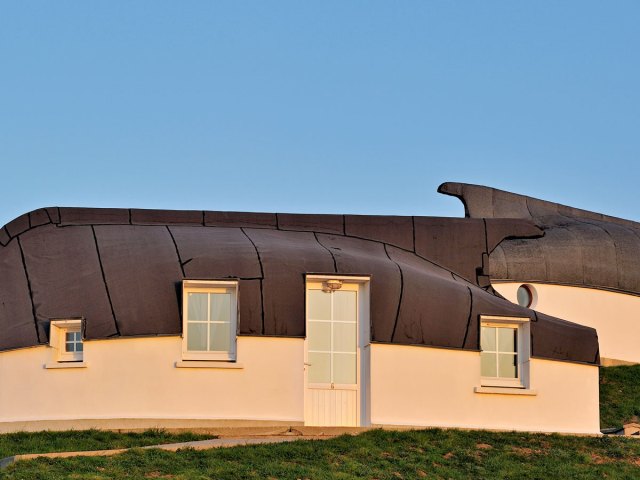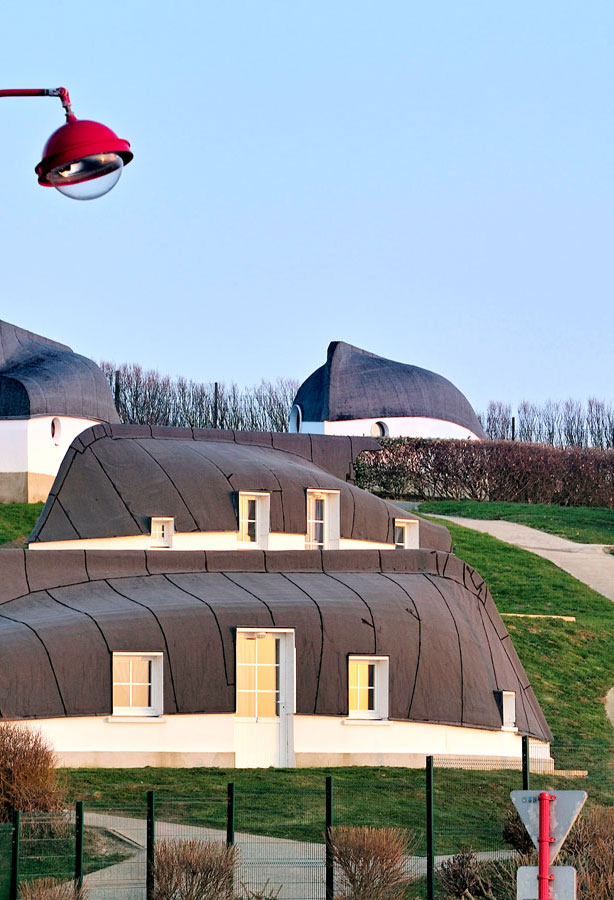The seaside commune of Équihen-Plage lies on a section of France’s northern coast called Côte d’Opale (Opal Coast), near the port city of Boulogne-sur-Mer. While the relaxed town draws in holidaymakers with its serene beaches, Équihen-Plage has a far more unusual claim to fame: its houses made out of upside-down boat hulls, known locally as quilles en l’air (which translates to “keels in the air” in English). If you’re wondering how these decommissioned fishing boats became unconventional abodes — and later unique accommodations for travelers — dive into the unique history of Équihen-Plage’s upside-down boats.
The Origins of the Boats

In the 19th and early 20th centuries, Équihen-Plage was a thriving fishing community. However, the sea here has a significant tidal range, and Équihen-Plage is an example of a port d’échouage, a port that has no water at low tide. Rather than drop anchor offshore, traditionally village fishermen would beach their boats and haul them up the sand by hand (though these days, you might see a tractor being used instead).
Their vessels, called flobarts, are traditional to northern France and have a number of characteristics that make them especially suited to places like Équihen-Plage. They were designed to be capable of floating in just a foot or so of water. Their wide bow was well equipped to deal with strong waves, while the flat stern could be slid into the water on logs whenever it needed to be launched.
How the Boat Houses Were Constructed

More than a century ago, money was tight for many in Équihen-Plage, and nothing was wasted. Boats that were no longer seaworthy were salvaged so they could be repurposed as homes, providing shelter for entire families at minimal cost. First, a low wall was constructed so that the finished dwelling would have sufficient headroom. A doorway-sized opening was then cut from the side of the boat, along with a small window or two. Builders then flipped the vessel over and lifted it on top of the wall. Many were tucked against the hillside, providing some protection against the elements on this wild and often windy coast. But in their original state, the boats would have been drafty and leaky.
The interiors of the quilles en l’air were also fairly basic, lacking adequate ventilation, natural light, and running water. Often simply and sparsely furnished, the boats had an open floor plan to maximize the space. Still, they rarely reached 26 feet long, often resulting in a tight squeeze, given the average family size of the time. But for many of these impoverished families, having an affordable roof over their heads would have been a blessing.
A New Era for the Quilles en L’Air

By the time World War II broke out, the days of the quilles en l’air were sadly numbered. In Équihen-Plage, the Quartier des Quilles en l’Air — the district that contained around 20 upturned boats — was a casualty of the bombing raids that flattened many of the buildings in this part of France. The last boat to be occupied was used as a studio by a painter named Paul Christol. It was the only boat to survive this era, albeit with significant damage.
Though the quilles en l’air were gone, they weren’t forgotten. By the 1990s, a desire to resurrect this old tradition arose. Local authorities decided to build new boat houses and rent them out to visitors vacationing in Équihen-Plage. Several decades later, they’re as popular as ever — and often fully booked well in advance.
How to Visit the Upside-Down Boats of Équihen-Plage

Today, the quilles en l’air are located within Camping La Falaise at the south end of Équihen-Plage. If you’re driving, follow Rue Charles Cazin to the main beach parking lot and walk back up to the campsite.
Aside from admiring the boats and their role in the region’s unique cultural history, visitors can also book them for a unique overnight stay. The replica boats are finished to a higher standard than the originals would have been and provide a comfortable, yet simple place to spend the night. In high season (July and August), rentals are only offered on a weekly basis, from Saturday to Saturday. Outside of peak season, visitors can reserve for shorter periods. Prices vary according to both season and size: Two of the eight boathouses sleep only two people, while the others can accommodate parties of up to five people. One is also accessible for people with limited mobility. And all of them have sea views..
If you’re planning to visit in early fall, it’s worth checking out Boulogne-sur-Mer’s Fête de la Beurière. This festival, which takes place during the second weekend in September, celebrates the fishing quarter’s history and traditions. There are typically local historians who will happily share old photos of the quilles en l’air and tell you their story.
To reach Équihen-Plage from Paris, catch a TER train from Gare du Nord to Boulogne-sur-Mer and take a 25-minute bus ride. From the other side of the English Channel, you can board a DFDS ferry to Calais, which makes the 90-minute sea crossing multiple times a day. A local bus connects the port and main train station, from where you can travel along the coast.
Other Upturned Boat Houses Around the World

Though Équihen-Plage’s quilles en l’air are certainly fascinating, they aren’t entirely unique — several other places in France, including Normandy and Brittany, are home to similar dwellings. Further afield, on the Holy Island of Lindisfarne in Northumberland, England, redundant herring boats have been turned upside down and given a new lease of life as boat sheds. Similarly, in places such as Greenland and Alaska, upturned umiaks (skin-covered boats) once created temporary shelters for local fishermen.
More from our network
Daily Passport is part of Inbox Studio, which publishes content that uplifts, informs, and inspires.
















